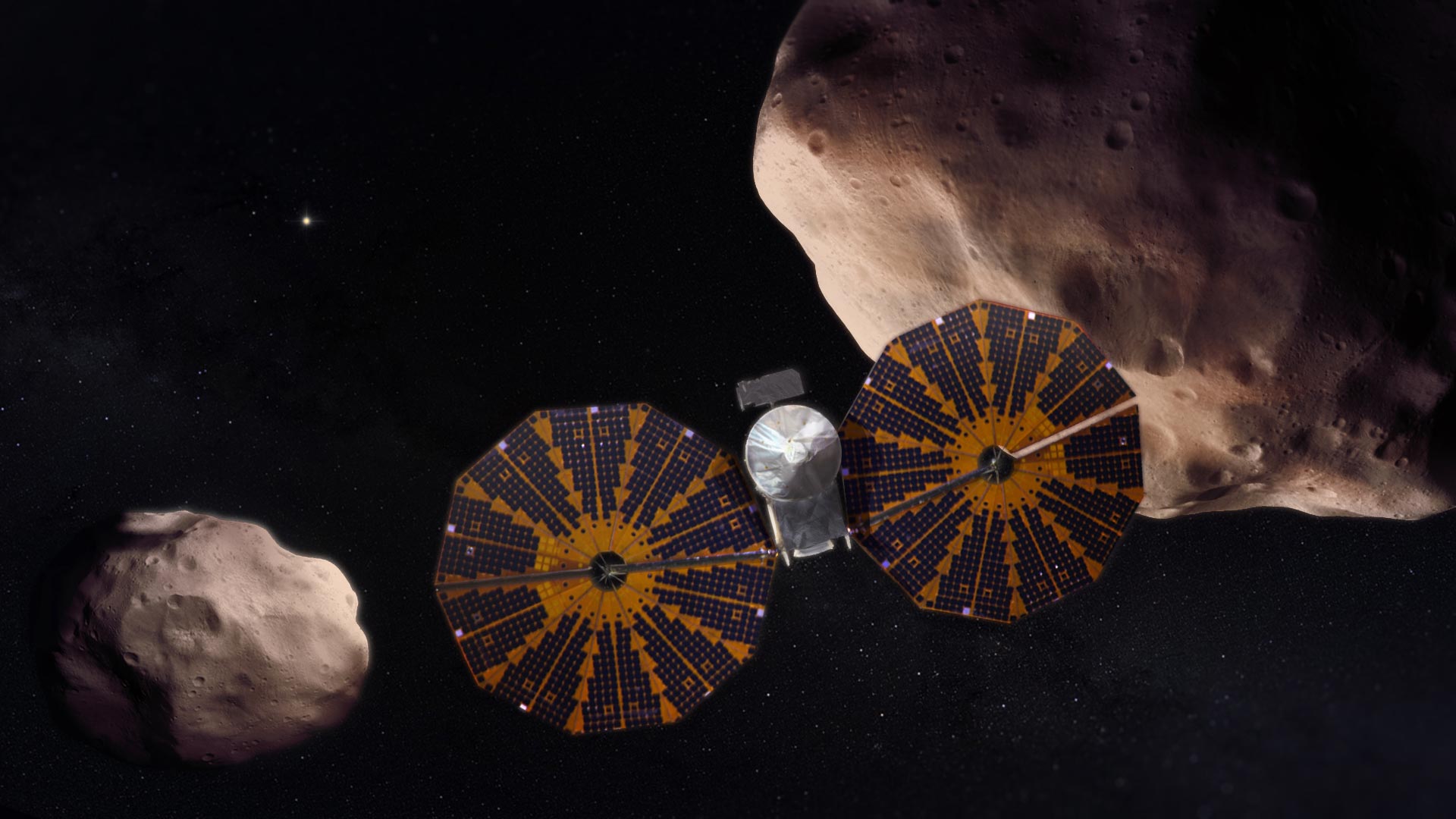その前に 始める 2021年10月、[{” attribute=””>NASA’s Lucy mission was already on course to break records by visiting more asteroids than any previous mission. Now, the mission can add one more asteroid to the list, after a surprise result from a long-running observation campaign.
Lucy’s science team discovered on March 27 that the smallest of the mission’s Trojan asteroid targets, Polymele, has a satellite of its own. On that day, Polymele was expected to pass in front of a star. This would allow the team to observe the star blink out as the asteroid briefly blocked, or occulted, it. The Lucy team planned to measure the location, size, and shape of Polymele with unprecedented precision while it was outlined by the star behind it. To do so, they spread 26 teams of professional and amateur astronomers across the path where the occultation would be visible.

A graphic showing the observed separation of asteroid Polymele from its discovered satellite. Credit: NASA’s Goddard Space Flight Center
These occultation campaigns have been enormously successful in the past, providing valuable information to the mission on its asteroid targets, but this day would hold a special bonus.
We were thrilled that 14 teams reported observing the star blink out as it passed behind the asteroid. However, as we analyzed the data, we saw that two of the observations were not like the others,” said Marc Buie, Lucy occultation science lead at the Southwest Research Institute, which is headquartered in San Antonio. “Those two observers detected an object around 200 km (about 124 miles) away from Polymele. It had to be a satellite.”

A graphic showing the observed separation of asteroid Polymele from its discovered satellite. Credit: NASA’s Goddard Space Flight Center
Using the occultation data, the scientists determined that this satellite is roughly 3 miles (5 km) in diameter, orbiting Polymele, which is itself around 17 miles (27 km) along its widest axis. The observed distance between the two bodies was approximately 125 miles (200 km).
Following planetary naming conventions, the satellite will not be issued an official name until the team can determine its orbit. As the satellite is too close to Polymele to be clearly seen by Earth-based or Earth-orbiting telescopes – without the help of a fortuitously positioned star – that determination will have to wait until Lucy approaches the asteroid in 2027, unless the team gets lucky with future occultation attempts before then.
At the time of the observation, Polymele was 480 million miles (770 million km) from Earth. Those distances are roughly equivalent to finding a quarter on a sidewalk in Los Angeles – while trying to spot it from a skyscraper thousands of miles away in Manhattan.

Using the occultation data, the team assessed that this satellite is roughly 3 miles (5 km) in diameter, orbiting Polymele, which is itself around 17 miles (27 km) along its widest axis. The observed distance between the two bodies was about 125 miles (200 km). Credit: NASA’s Goddard Space Flight Center
Asteroids hold vital clues to deciphering the history of the solar system – perhaps even the origins of life. Solving these mysteries is a high priority for NASA. The Lucy team originally planned to visit one main belt asteroid and six Trojan asteroids, a previously unexplored population of asteroids that lead and follow Jupiter in its orbit around the Sun. In January of 2021, the team used the Hubble Space Telescope to discover that one of the Trojan asteroids, Eurybates, has a small satellite. Now with this new satellite, Lucy is on track to visit nine asteroids on this remarkable 12-year voyage.
“Lucy’s tagline started out: 12 years, seven asteroids, one spacecraft,” said Lucy program scientist Tom Statler at NASA Headquarters in Washington. “We keep having to change the tagline for this mission, but that’s a good problem to have.”
2020年1月9日、Lucy Missionは公式に7つではなく8つの小惑星を訪問すると発表しました。 明らかなように、ルーシーの道に沿った小惑星の1つであるEurybatesには小さな衛星があります。 Lucyチームが衛星を発見した直後、LucyチームとEurybatesはどちらも太陽の後ろに移動し、チームが衛星を観測できなくなりました。 しかし、2020年7月の太陽の後ろに小惑星が現れ、その後Lucyチームはハッブルと一緒に衛星を何度も観察することができ、チームが衛星の軌道を正確に定義し、小さな衛星がついに正式名称 – Queta。
Lucyのチーフ研究者は、サンアントニオテキサス州に本部を置くサウスウェスト研究所の支店であるコロラド州ボルダーに基づいています。 メリーランド州グリーンベルトにあるNASAのGoddard宇宙飛行センターは、全体的なミッション管理、システムエンジニアリング、安全、ミッション保証を提供しています。 コロラド州リトルトンにあるロッキード・マーティン・スペース(Lockheed Martin Space)が宇宙船を作りました。 LucyはNASAのディスカバリープログラムの13番目のミッションです。 アラバマ州ハンツビルにあるNASAのマーシャル宇宙飛行センターは、ワシントンにあるこの機関の科学ミッション部門の発見プログラムを管理しています。















+ There are no comments
Add yours